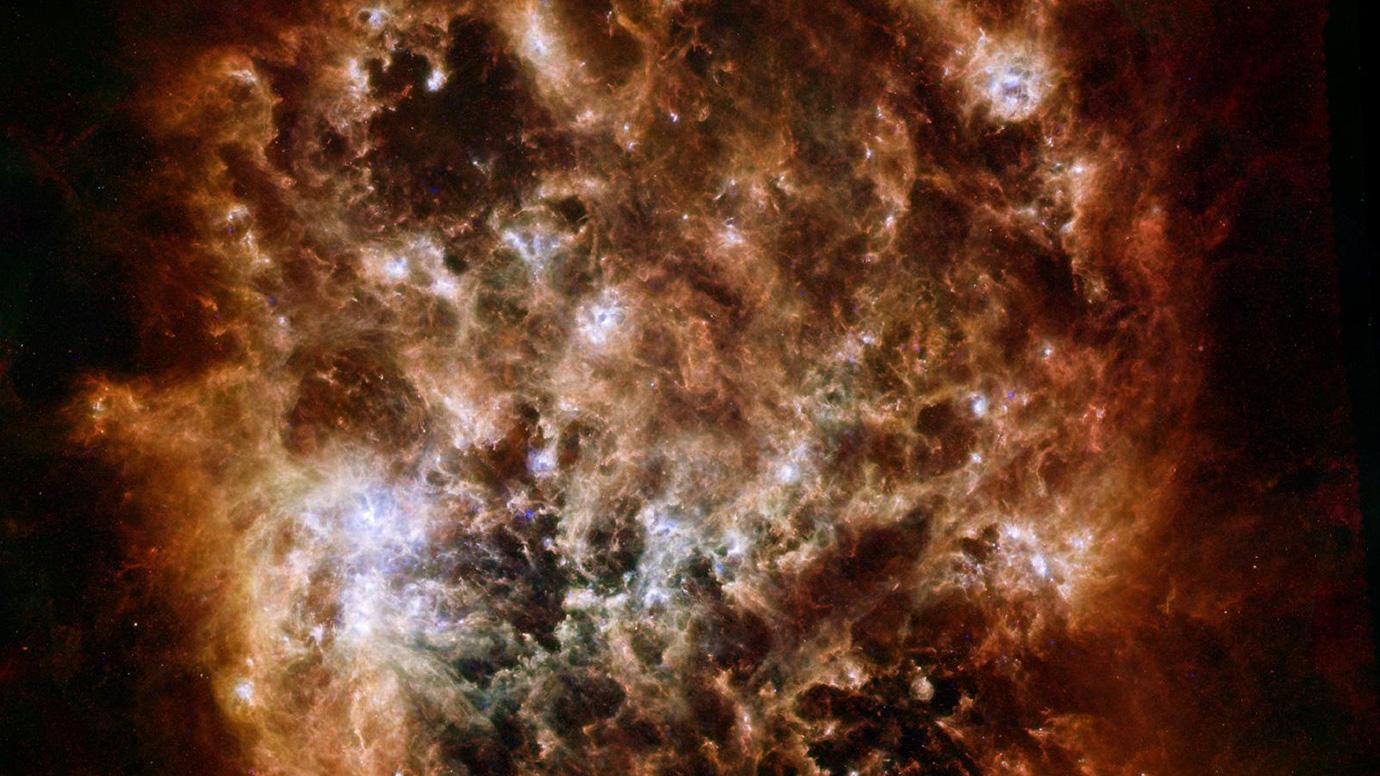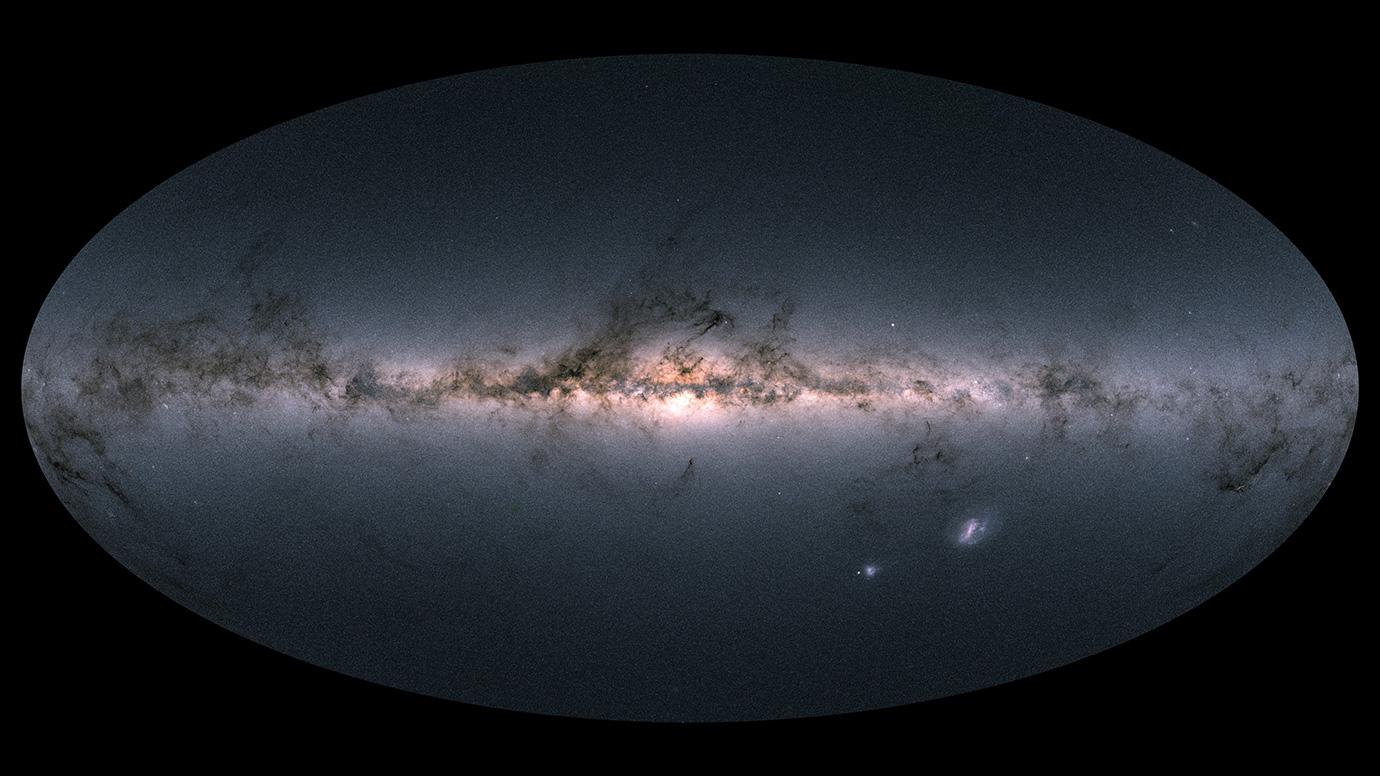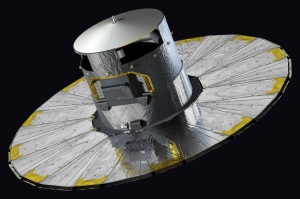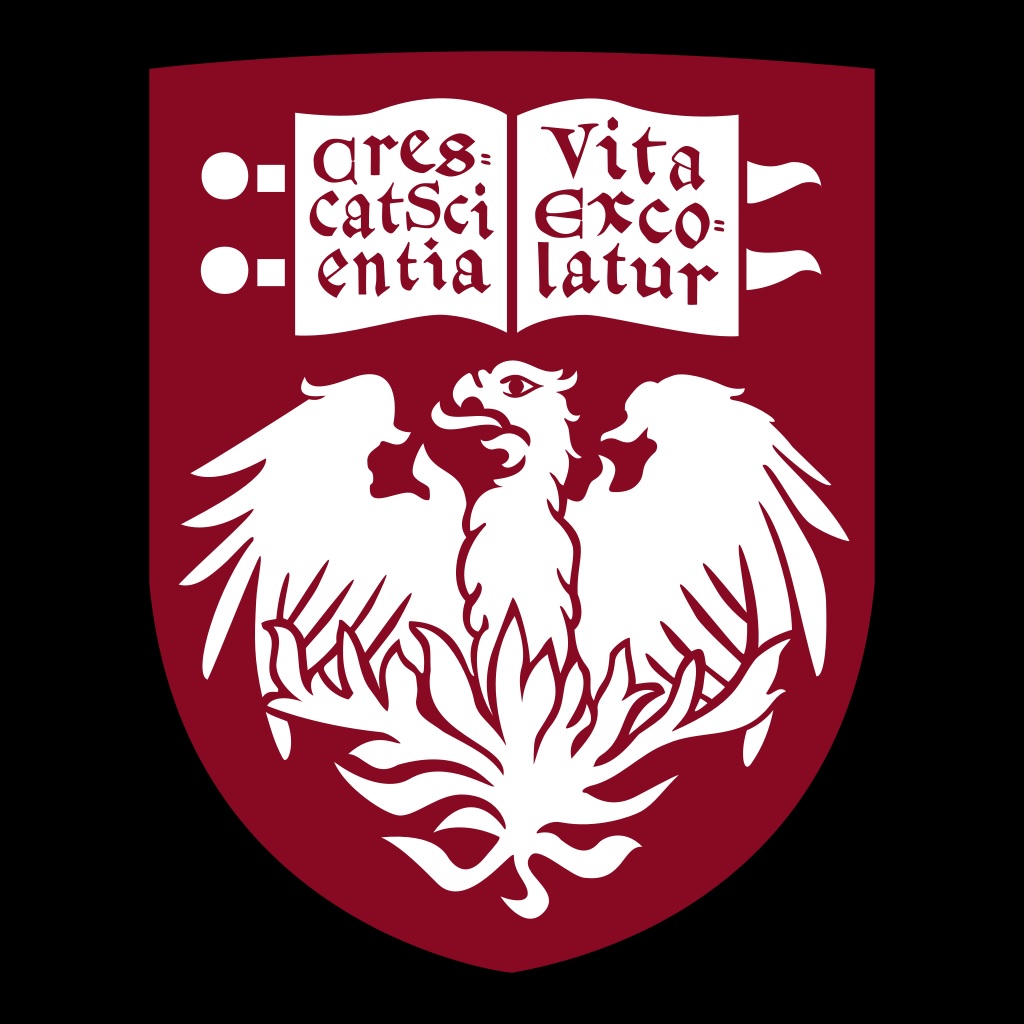From The University of Chicago
3.20.24
Louise Lerner

The Large Magellanic Cloud, a galaxy that fell into ours billions of years ago, could help reveal how the universe evolved in other regions. Above, images of the Cloud taken in infrared light. Image courtesy NASA/JPL-Caltech.
Stars from the Large Magellanic Cloud reveal new hints about how the universe got its elements.
The first generation of stars transformed the universe. Inside their cores, simple hydrogen and helium fused into a rainbow of elements. When these stars died, they exploded and sent these new elements across the universe. The iron running in your veins and the calcium in your teeth and the sodium powering your thoughts were all born in the heart of a long-dead star.
No one has been able to find one of those first generation of stars, but scientists have announced a unique finding: a star from the second generation that originally formed in a different galaxy from ours.
“This star provides a unique window into the very early element-forming process in galaxies other than our own,” said Anirudh Chiti, a University of Chicago postdoctoral fellow and first author on a paper announcing the findings. “We have built up an idea of the how these stars that were chemically enriched by the first stars look like in the Milky Way, but we don’t yet know if some of these signatures are unique, or if things happened similarly across other galaxies.”
The paper was published March 20 in Nature Astronomy.
‘Fishing needles out of haystacks’
Chiti specializes in what is called stellar archaeology: Reconstructing how the earliest generations of stars changed the universe. “We want to understand what the properties of those first stars were and what were the elements they produced,” said Chiti.
But no one has yet managed to directly see these first-generation stars, if any remain in the universe. Instead, Chiti and his colleagues look for stars that formed from the ashes of that first generation.
It’s hard work, because even the second generation of stars is now incredibly ancient and rare. Most stars in the universe, including our own sun, are the result of tens to thousands of generations, building up more and more heavy elements each time. “Maybe fewer than 1 in 100,000 stars in the Milky Way is one of these second-gen stars,” he said. “You really are fishing needles out of haystacks.”
But it’s worth it to get snapshots of what the universe looked like back in time. “In their outer layers, these stars preserve the elements near where they formed,” he explained. “If you can find a very old star and get its chemical composition, you can understand what the chemical composition of the universe was like where that star formed, billions of years ago.”
An intriguing oddity
For this study, Chiti and his colleagues aimed their telescopes at an unusual target: the stars that make up the Large Magellanic Cloud.
The Large Magellanic Cloud is a bright swath of stars visible to the naked eye in the Southern Hemisphere. We now think it was once a separate galaxy that was captured by the Milky Way’s gravity just a few billion years ago. This makes it particularly interesting because its oldest stars were formed outside the Milky Way—giving astronomers a chance to learn about whether conditions in the early universe all looked the same, or were different in other places.

The Large and Small Magellanic Clouds are visible at the lower right-hand corner of this image of the Milky Way as seen by the European Space Agency’s Gaia satellite. Image courtesy ESA/Gaia/DPAC.

The scientists searched for evidence of these particularly ancient stars in the Large Magellanic Cloud and catalogued ten of them, first with the European Space Agency’s Gaia satellite and then with the Magellan Telescope in Chile.

One of these stars immediately jumped out as an oddity. It had much, much less of the heavier elements in it than any other star yet seen in the Large Magellanic Cloud. This means it was probably formed in the wake of the first generation of stars—so it had not yet built up heavier elements over the course of repeated star births and deaths.
Mapping out its elements, the scientists were surprised to see that it had a lot less carbon than iron compared to what we see in Milky Way stars.
“That was very intriguing, and it suggests that perhaps carbon enhancement of the earliest generation, as we see in the Milky Way, was not universal,” Chiti said. “We’ll have to do further studies, but it suggests there are differences from place to place.
“I think we’re filling out the picture of what the early element enrichment process looked like in different environments,” he said.
Their findings also corroborated other studies that have suggested that the Large Magellanic Cloud made much fewer stars early on compared to the Milky Way.
Chiti is currently leading an imaging program to map out a large portion of the southern sky to find the earliest stars possible. “This discovery suggests there should be many of these stars in the Large Magellanic Cloud if we look closely,” he said. “It’s really exciting to be opening up stellar archeology of the Large Magellanic Cloud, and to be able to map out in such detail how the first stars chemically enriched the universe in different regions.”
University of Chicago scientists Guilherme Limberg and Asst. Prof. Alex Ji were also authors on the paper; other authors included scientists from Zarqua University, the University of Tokyo, the Joint Institute for Nuclear Astrophysics, MIT, the University of Sao Paolo, Gemini Observatory/NOIRLab, the University of Wisconsin-Madison, The Harvard and Smithsonian Center for Astrophysics, the University of Toronto, and the Observatories of the Carnegie Institution for Science.
See the full article here .
Comments are invited and will be appreciated, especially if the reader finds any errors which I can correct.
five-ways-keep-your-child-safe-school-shootings
Please help promote STEM in your local schools.
The University of Chicago is an urban research university that has driven new ways of thinking since 1890. Our commitment to free and open inquiry draws inspired scholars to our global campuses, where ideas are born that challenge and change the world.
We empower individuals to challenge conventional thinking in pursuit of original ideas. Students in the College develop critical, analytic, and writing skills in our rigorous, interdisciplinary core curriculum. Through graduate programs, students test their ideas with University of Chicago scholars, and become the next generation of leaders in academia, industry, nonprofits, and government.
University of Chicago research has led to such breakthroughs as discovering the link between cancer and genetics, establishing revolutionary theories of economics, and developing tools to produce reliably excellent urban schooling. We generate new insights for the benefit of present and future generations with our national and affiliated laboratories: the DOE’s Argonne National Laboratory, the DOE’s Fermi National Accelerator Laboratory , and the Marine Biological Laboratory in Woods Hole, Massachusetts.
The University of Chicago is enriched by the city we call home. In partnership with our neighbors, we invest in Chicago’s mid-South Side across such areas as health, education, economic growth, and the arts. Together with our medical center, we are the largest private employer on the South Side.
In all we do, we are driven to dig deeper, push further, and ask bigger questions—and to leverage our knowledge to enrich all human life. Our diverse and creative students and alumni drive innovation, lead international conversations, and make masterpieces. Alumni and faculty, lecturers and postdocs have gone on to become Nobel laureates, CEOs, university presidents, attorneys general, literary giants, and astronauts. The University of Chicago was founded in 1890. Its main campus is located in Chicago’s Hyde Park neighborhood. The University of Chicago is ranked among the top universities in the world by major education publications, and it is among the most selective in the United States.
The university is composed of one undergraduate college and five graduate research divisions, which contain all of the university’s graduate programs and interdisciplinary committees. Chicago has eight professional schools: the Law School, the Booth School of Business, the Pritzker School of Medicine, the School of Social Service Administration, the Harris School of Public Policy, the Divinity School, the Graham School of Continuing Liberal and Professional Studies, and the Pritzker School of Molecular Engineering. The university has additional campuses and centers in London, Paris, Beijing, Delhi, and Hong Kong, as well as in downtown Chicago.
University of Chicago scholars have played a major role in the development of many academic disciplines, including economics, law, literary criticism, mathematics, religion, sociology, and the behavioralism school of political science, establishing the Chicago schools in various fields. Chicago’s Metallurgical Laboratory produced the world’s first man-made, self-sustaining nuclear reaction in Chicago Pile-1 beneath the viewing stands of the university’s Stagg Field. Advances in chemistry led to the “radiocarbon revolution” in the carbon-14 dating of ancient life and objects. The university is also home to the University of Chicago Press, the largest university press in the United States. The Barack Obama Presidential Center is expected to be housed at the university and will include both the Obama presidential library and offices of the Obama Foundation.
The University of Chicago’s students, faculty, and staff have included many Nobel laureates. The university’s faculty members and alumni also include Fields Medalists, Turing Award winners, MacArthur Fellows, Marshall Scholars, Pulitzer Prize winners, National Humanities Medalists, living billionaire graduates, and a number of Olympic medal winners.
Research
The University of Chicago is classified among “R1: Doctoral Universities – Very high research activity” and is a founding member of the Association of American Universities and was a member of the Committee on Institutional Cooperation from 1946 through June 29, 2016, when the group’s name was changed to the Big Ten Academic Alliance. The University of Chicago is not a member of the rebranded consortium, but will continue to be a collaborator.
The university operates more than 140 research centers and institutes on campus. Among these are the Oriental Institute—a museum and research center for Near Eastern studies owned and operated by the university—and a number of National Resource Centers, including the Center for Middle Eastern Studies. Chicago also operates or is affiliated with several research institutions apart from the university proper. The university manages the DOE’s Argonne National Laboratory, part of the United States Department of Energy’s national laboratory system, and co-manages the DOE’s Fermi National Accelerator Laboratory, a nearby particle physics laboratory, as well as a stake in the the Apache Point Observatory in Sunspot, New Mexico.
______________________


______________________
Faculty and students at the adjacent Toyota Technological Institute at Chicago collaborate with the university. In 2013, the university formed an affiliation with the formerly independent Marine Biological Laboratory in Woods Hole, Mass. Although formally unrelated, the National Opinion Research Center is located on Chicago’s campus.


